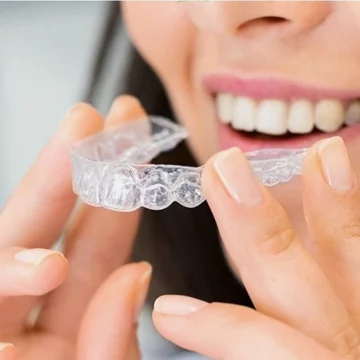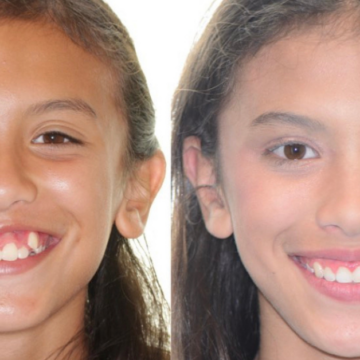Are you noticing more kids wearing braces at a younger age? Do you wonder if your kids should get braces too? You may think that starting orthodontic treatment at a young age (7-8 years old) is better but in reality, early orthodontic treatment is neither necessary nor beneficial for most children. Here are some of the most frequently asked questions about early orthodontic treatment.
My dentist recommended that I take my 7-year-old child to an orthodontist for an evaluation. Is this really necessary?
The American Association of Orthodontists recommends orthodontic screening of all children 7 years or older. At age 7, most children already have all of their first molars and the first set of permanent incisors. Most orthodontic problems can be diagnosed or predicted at this age. Common issues include:
1. Missing or extra teeth
2. Tooth growth problems
3. Bite problems
4. Space problems (crowding or spacing)
5. Jaw growth discrepancies
6. Bad oral habits (examples: thumb sucking, tongue thrusting, etc…)
When is orthodontic treatment indicated for younger children?
Most children would not benefit for orthodontic treatment at a young age (7-8 years old). There are, however, specific indications for early orthodontic treatment, and they mostly have to do with bite problems:
1. Anterior crossbites (one or more upper front teeth biting behind the lower front teeth)
2. Posterior crossbites (one or more back teeth biting inside the lower back teeth)
3. Abnormal oral habits (thumb sucking)
4. Underbite (lower jaw outgrowing the upper jaw)
5. Deep traumatic overbite (lower front teeth biting into the roof of the mouth and causing pain and/or tissue damage)
6. Severe overbite putting front teeth at higher risk of injury
7. Severe jaw underdevelopment causing breathing difficulties
8. Impaction (failure of tooth growth) of permanent molars or incisors
9. Social reasons (child teased at school because of his/her teeth)
The following orthodontic problems are NOT good indications for early treatment
1. Crowding: believe it or not, using an expander or braces to straighten teeth at a young age to correct crowding in the absence of another orthodontic problem is not beneficial and may in fact have side effects (cavities, white spots, root damage, etc…). Using expanders in the absence of a crossbite is virtually a total waste since the upper jaw will eventually go back to its original dimension. This has been demonstrated in several clinical studies.
2. Mild to moderate overbite: the benefits of early orthodontic treatment to address a mild-to-moderate overbite are questionable at best. Multiple studies and large systematic reviews showed that there is little to no benefit of early orthodontic treatment to correct an increased overbite. For that reason, early orthodontic treatment should be avoided in these cases unless there is an associated trauma risk or breathing problems.
3. Spacing: spacing between teeth is actually a good thing and should not be addressed until all permanent teeth grow
If my child gets braces at a young age, will he/she need braces again in the future?
Most likely yes. Early orthodontic treatment is often referred to as Phase I orthodontic treatment, indicating that Phase II treatment will be needed once most or all permanent teeth grow. This means that in totality, your child will wear braces for a longer time, thus increasing the cost and potential side effects of orthodontic treatment. This is the main reason why early orthodontic treatment should be avoided unless there is a clear indication for it.
My dentist recommended an expander for my child. What are expanders anyway? Do they work?
Palatal expanders are appliances that are used to widen the upper jaw. Expanders are very effective and can be extremely beneficial if used in the right scenario (crossbite or underdeveloped upper jaw). Expanders, however, are not as effective to address dental crowding if there is no crossbite present. In these cases, the expansion achieved is almost completely lost a few months after finishing the treatment.
Can Invisalign be used for early orthodontic treatment?
Invisalign recently launched a new product line called Invisalign First which is designed specifically for growing children. Invisalign aligners cannot substitute for orthopedic appliances (such as expanders and facemasks) but may be used instead of brackets (braces).
What's the best age to start orthodontic treatment?
This is perhaps the most important question. Starting orthodontic treatment at the right time increases the chances for success and minimizes overall treatment time. Dental development is highly variable among different ages, therefore, a child’s age is not an accurate way to time orthodontic treatment. The best approach is to perform a full evaluation at age 7 and continue to see the orthodontist on a regular basis (usually yearly) until the right time to start treatment comes. This is the best approach to pick the right time for your child’s orthodontic treatment. We offer complimentary orthodontic evaluations for all of our patients starting at age 7. You can read more on this subject here. Call us now or book your child’s orthodontic evaluation in Hinsdale online and we will gladly guide you through the process to ensure the best outcome for your child.
Dr. Ramzi Daibis is a board-certified orthodontist and the owner of Band & Wire Orthodontics in Clarendon Hills, IL. He specializes exclusively in braces and Invisalign for children and adults. Band & Wire Orthodontics serves Clarendon Hills, Hinsdale, Westmont, Downers Grove, Oak Brook, Willowbrook, Burr Ridge, Western Springs, La Grange, La Grange Park and Chicago.



